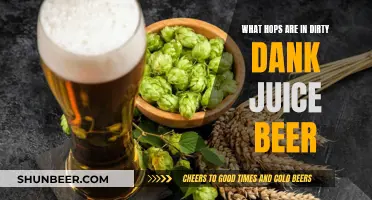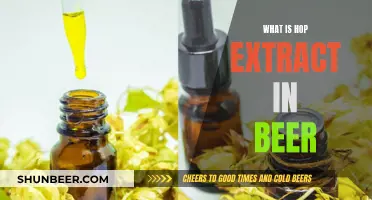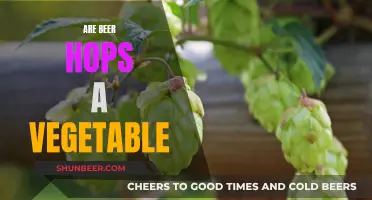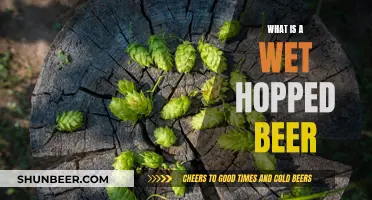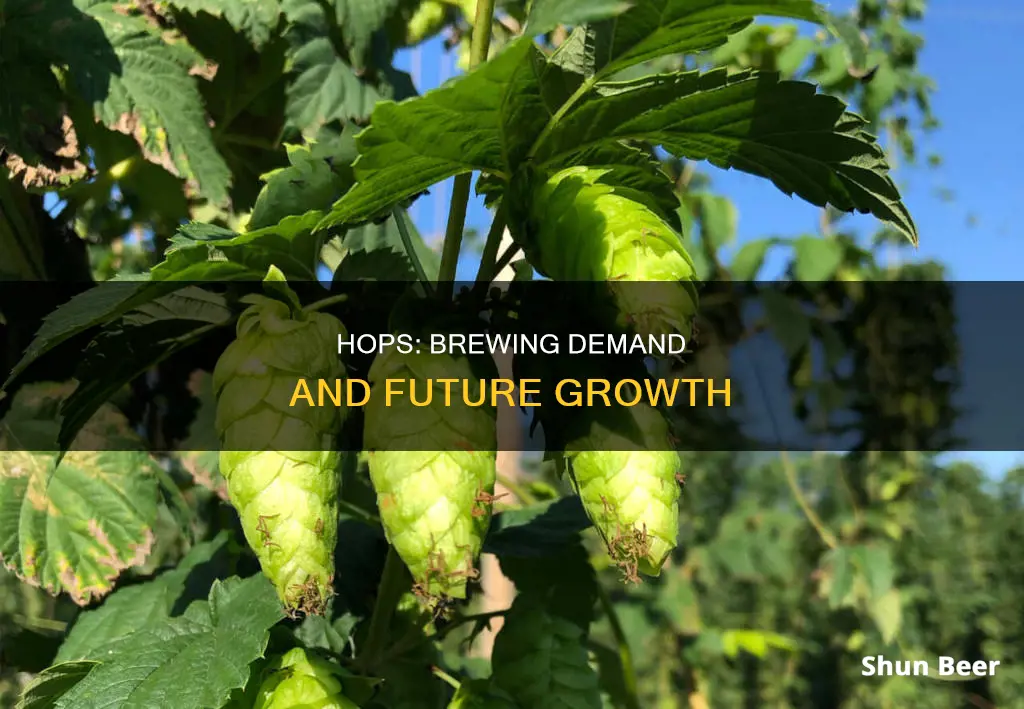
Hops are the flowers of the hop plant Humulus lupulus, a member of the Cannabaceae family of flowering plants. They are one of the four essential ingredients in beer, alongside barley, yeast, and water. Hops add bitterness, flavour, and stability to the finished beer, and help it stay fresh for longer. They are also used in herbal medicine and to make herbal teas and soft drinks.
Hops are in high demand due to their unique role in the beer-making process and the distinct characteristics they impart on the final product.
| Characteristics | Values |
|---|---|
| Scientific name | Humulus lupulus |
| Plant type | Climbing herbaceous perennial |
| Plant family | Cannabaceae |
| Plant gender | Female |
| Plant part used | Flowers (seed cones or strobiles) |
| Flavour | Bitter, floral, fruity, citrus |
| Aroma | Citrus, pine, mango, resin, melon |
| Other uses | Herbal medicine, herbal teas, soft drinks |
What You'll Learn

Hops are the flowers of the female hop plant, Humulus lupulus
The female hop plant has cone-shaped flowers (hops) that are used primarily in beer brewing. The hops add bitterness, flavour, and act as a stabilising agent in beer. They also impart floral, fruity, or citrus flavours and aromas to the beer. The female plants are propagated vegetatively, while the male plants are culled if grown from seeds.
The hop plant is dioecious, meaning it has separate male and female plants. The female flowers are formed in clusters at the tips of the plant's stalks and have no petals but long styles. In contrast, the male flowers also form in clusters but differ in appearance, with spreading sepals and short stamens.
The hop plant is grown commercially, and only the female plants are used for beer production. The plants are usually trained to grow up strings in a field, and the cones are picked by hand or using a mechanical hops separator. The cones are then dried in an oast house to reduce moisture content before being compressed into bales.
The chemical composition of hops includes alpha acids or humulones, which provide the bitter taste of beer, and beta acids or lupulones, which contribute to the aroma. Hops also contain essential oils, such as terpene hydrocarbons, consisting of myrcene, humulene, and caryophyllene, which give hops their distinctive pungent smell.
Hops in Beer: Vegetable or Not?
You may want to see also

Hops add aroma, flavour, and bitterness to beer
Hops are the flowers, or cones, of the female hop plant, Humulus lupulus. They are added to beer to add aroma, flavour, and bitterness. Hops have been used in brewing beer for centuries, originally for their preservative properties. Today, hops are still used to extend the shelf life of beer, but they also play a crucial role in defining its flavour and aroma profiles.
The brewing value of hops comes from the resins and oils inside the lupulin glands of the hop cones. Hops are divided into three types: bittering, finishing, and dual-use. Bittering hops have high alpha-acid levels, which give beer its unique bitter flavour. Finishing hops have high aroma levels, adding floral, fruity, or citrus flavours and aromas. Dual-use hops are a combination of both.
The timing of when hops are added during the brewing process also affects the flavour and aroma of the beer. Hops added early in the process impart more bitterness, as they release more alpha acids the longer they boil. Hops added later in the process emphasise their aromatics and impart less bitterness.
Different varieties of hops are used for particular styles of beer. Some popular varieties include Cascade, Centennial, and Chinook, each with its own unique characteristics. Brewers often use a combination of hops to achieve the desired taste profile for their beer.
Grow Your Own Hops for Beer: A Step-by-Step Guide
You may want to see also

Hops are used at different stages of the brewing process
Hops are added at different stages of the brewing process to extract different flavours and aromas. Hops are the flowers of the hop plant, *Humulus lupulus*, and are used primarily as a bittering, flavouring, and stabilising agent in beer. They are also used for their antibacterial properties, which help to prevent spoilage.
Hops are typically added to wort in three stages during the boil: bittering, flavour, and aroma. However, some beers may have only one addition, while others may have up to five or six. All beers will have at least one hop addition for bitterness, to balance the sweetness of the malt.
Bittering hops are added once the wort has been collected in the kettle and a rolling boil has been achieved. They are usually boiled for 60 minutes, although some recipes may call for as little as 30 minutes. The longer the hops are boiled, the more bittering qualities are extracted, as the alpha acids in the hops isomerise with heat.
Flavouring hops are generally added with between 15 and 30 minutes remaining in the boil. During this time frame, very little bitterness will be extracted, but the crisp hoppy flavour will be imparted.
Aroma hops are added during the final 10 minutes or less of the boil. The hop oils responsible for aroma are extremely volatile and will be driven off in the steam of the boil almost immediately. Therefore, they must not be boiled for long to preserve their aromatic qualities.
In addition to these three stages, hops can also be added post-boil and post-chill. Post-boil hops are added after the heat is killed but before the wort has been chilled, while post-chill hops, also known as dry hops, are added after the wort has been chilled. Dry hopping is a common practice that adds aroma and flavour to the beer without contributing measurable IBUs (International Bittering Units), as there is no heat involved.
Beer Hops Allergy: What You Need to Know
You may want to see also

Hops are categorised by their geography of origin
Hops, the flowers of female Humulus lupulus plants, are categorised by their geography of origin. The United States of America is the world's largest producer of hops, with the country accounting for 40% of world hop production and 39% of world hop acreage in 2019. The largest hop producers in the US can be found in the Pacific Northwest, throughout Washington's Yakima Valley.
Historically, hops varieties were identified by geography, for example, from the towns of Hallertau, Spalt, and Tettnang in Germany, or the region writ large like the Neomexicanus hops of New Mexico. The first documented hop cultivation was in 736, in the Hallertau region of present-day Germany, although the first mention of the use of hops in brewing in that country was in 1079. Hallertau or Hallertauer hops are named after the Holledau region in central Bavaria and are the original German lager hop. Spalt hops, meanwhile, are traditional German noble hops from the Spalter region south of Nuremberg. Tettnang hops come from Tettnang, a small town in southern Baden-Württemberg in Germany, and are used in European pale lagers, sometimes in conjunction with Hallertau hops.
In the UK, the principal production centres are in Kent, Herefordshire, and Worcestershire. Kent produces Kent Goldings hops, which are used in British ales.
In the US, hops are grown in most of the continental United States and Canada, but commercial production requires a particular environment. The Pacific Northwest region, including Washington, Oregon, and Idaho, is ideal for growing hop bines due to its optimal climate, availability of water, and proper soil type. The state of Oregon is home to the USDA-ARS public breeding program, which has developed Cascade and other "c-hop" varietals. Oregon hop production primarily occurs in the Willamette Valley region. Washington is the largest hop-producing state in the country, with hops first introduced to the state in 1865. Idaho began producing hops in the 1950s and is home to one of the largest hop farms in the world, the 1,700-acre Elk Mountain Farms.
Where to Find Tropical Hop Beer Near You
You may want to see also

Hops are related to the cannabis plant
Hops (Humulus) and cannabis (weed) are closely related cousins, both belonging to the Cannabaceae family of flowering plants. Their shared lineage dates back around 25 million years, when they evolved from a common ancestor, with hops veering towards damper environments near creek beds and cannabis finding solace in the drier terrains of the savannahs.
Both plants share several morphological and genetic similarities. They exhibit palmately lobed leaves and the presence of stipules, cystoliths, and laticifers—secretory tissues that play a role in deterring herbivory.
However, their ecological preferences differ. Hops, a climbing plant, thrives in moist, temperate regions, while cannabis stands upright and prefers drier, warmer climates.
The resinous glands of both plants produce distinct compounds. Hops produce alpha and beta acids, which lend beers their bitter taste and aid in preservation. Cannabis, on the other hand, produces cannabinoids like THC and CBD, sought after for their recreational and medicinal effects.
Despite their divergent paths and unique characteristics, the kinship between hops and cannabis is undeniable, offering a fascinating insight into the evolutionary history of two of society's most cherished botanicals.
Hops' Preservative Powers: Keeping Beer Fresh
You may want to see also
Frequently asked questions
Hops are the flowers, or cones, of a plant called Humulus lupulus. They are one of the four main ingredients in beer, alongside malt, water, and yeast.
Hops help to balance the sweetness of the malt with bitterness and a variety of flavours and aromas. They also act as a preservative, keeping beer fresher for longer.
Hops can be categorised in several ways. One way is by their geographical origin, with the three most prominent categories being Noble hops (from Germany and the Czech Republic), American hops, and English hops. Another way is by their function, with the two main types being bittering hops and aroma hops.
Hops are in high demand for beer production, with every single beer on the market today containing hops. They are also used in other beverages and herbal medicine.



